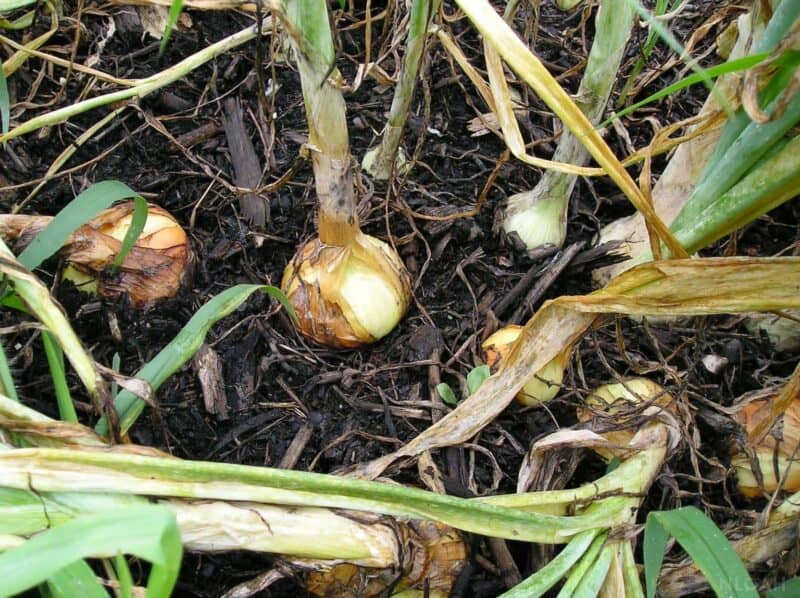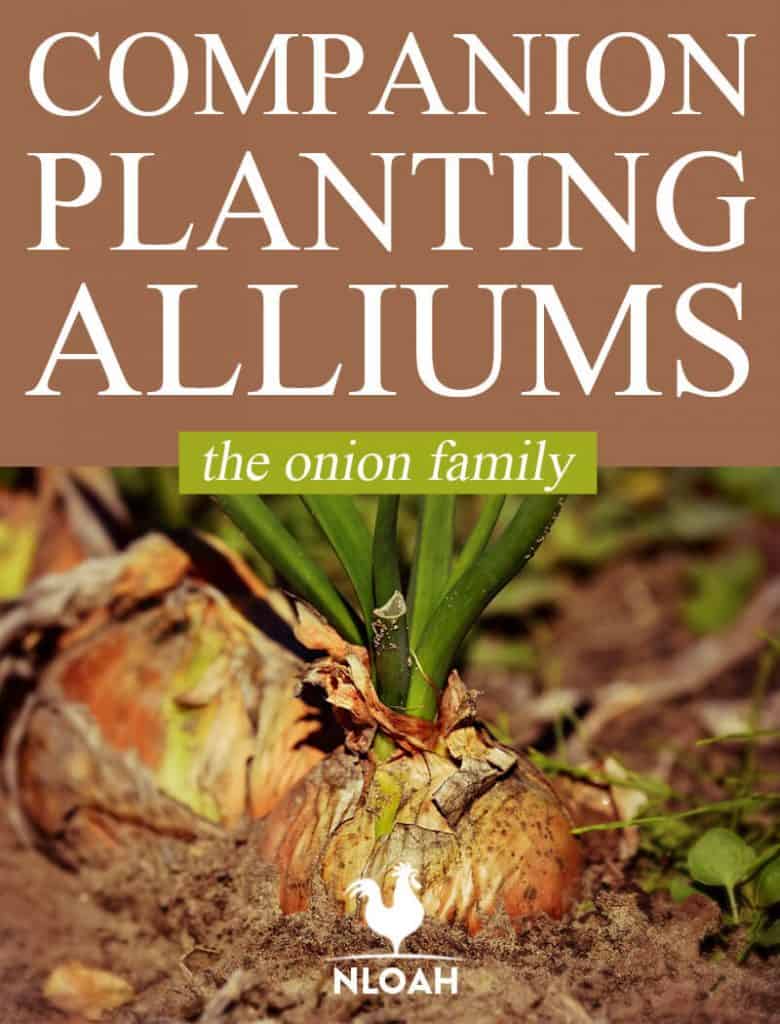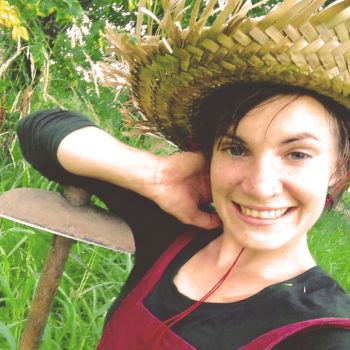Companion planting is the conscious act of pairing plants together to form guilds of crops that support each other.
By purposefully choosing certain plants to sit next to each other in the soil, you’re able to create more resilient systems in your garden that lead to more fruitful crops, with higher yields and better quality harvests.

The allium family, which includes onions, leeks, garlic, shallots, and so on, is actually a great companion in your garden. The strong scent helps to deter unwanted pests from your other plants. However, there are some plants that benefit alliums too. Here we talk about why you should be companion planting onions and with what.
What to Consider Before Companion Planting Alliums
Alliums, the onion family, like certain conditions to grow in. You need to consider this when choosing supporting and complementary plants to sit alongside them.
Firstly, alliums aren’t really fussy about soil conditions but they don’t like to have wet feet. While they grow in most soils, they definitely prefer sandy, loamy soil. In this sense, if you have quite boggy soil, consider planting a thirsty plant next to it to drink up the excess water.
Secondly, while not fussy, alliums do thrive best when the soil is slightly acidic. While you can add certain amendments to the soil in order to remedy this, there are trees that can naturally change the pH, such as pine trees.
Pine trees will turn the soil slightly acidic over time, but remember not to plant them where they block the sunlight.
In terms of sun, alliums like a full day of full sunshine. When you’re considering placement of your alliums and companion plants, don’t plant anything taller than your onions in front of the sun.
In this sense, you want your alliums facing south, with taller plants on the north side. Equally, alliums tend to reach about 1-2 feet in height. Don’t place smaller sun-loving plants behind them or the alliums will block out the sunshine for the smaller plants.
Companion Plants for Alliums
Interestingly, alliums are actually a massive helper to other plants. For many families of plants, alliums are a really good companion due to their strong scent.
The smell they emit works to keep away pests, meaning that alliums are often used as a pest management crop and are planted in little pockets all over the garden.
Pest and Disease Management
Cucumbers – Cucumbers help to prevent fungus issues with alliums, especially powdery mildew.
Carrots – Firstly, and most obviously, carrots grow under the soil meaning they do not compete for nutrients with onions as they have a deeper root system. In terms of pest control, alliums deter carrot flies and carrots deter onion flies, making them the ideal companions for each other. Find more companion plants for carrots here.
Brassicas – The brassica family, which includes kales, cabbages, broccoli, and cauliflower, all benefit from having onions nearby, as onions deter aphids, cabbage loopers, cabbage maggots, and cabbage worms thanks to their strong scent.
Strawberries – Strawberries benefit from having an onion or two near them as the onions can prevent verticillium wilt and deter aphids. Here’s more companion plants for strawberries.
Leeks – In general, you shouldn’t plant alliums near alliums, however leeks do confuse onion flies, so you can plant them near onions.
Lettuce – Alliums and lettuce have no root competition, and the smell of the alliums deters all kinds of pests from eating the lettuce leaves, such as slugs and even rabbits.
Tomatoes and Peppers – Tomatoes and peppers are also susceptible to verticillium wilt, and onions can keep this at bay. Onions also deter red spider mites and aphids.
Celery – Celery works very similarly to carrots by deterring onion flies.
Parsley – Parsley also keeps onions, flies, and maggots away.
Marigolds – Marigolds release a toxin from their roots which kills off root knot nematodes. They also deter onion flies and attract beneficial insects.
Flavor Enhancers
Peppers – Spicy peppers are said to enhance the flavor of alliums due to the high level of sulfur in the alliums. The spicier the pepper, the more you’ll notice the difference.
Chamomile – Chamomile is rumored to increase oil production in many plants. The oils in alliums are responsible for the flavor so planting chamomile nearby will enhance their taste.
Summer Savoury – Summer savory is said to make the onions taste juicer.
What Should Not Be Planted With Alliums?
Peas and Beans – Although peas and beans increase nitrogen in the soil which helps the alliums, the alliums don’t return the favor. Instead they emit a chemical called ‘ajoene’ which stunts the growth of the peas and beans.
Turnips – This same chemical also stunts the growth of turnips, and deteriorates the taste.
Asparagus – Onions also inhibit the growth of asparagus.
Other Alliums – Onion flies are attracted to the scent of alliums. If you place a lot of them together, it’s like sending a beacon out to attract all the onion flies at once for a big feast. Try to scatter your alliums around the garden.
Onions and alliums are a great companion for the garden – especially when it comes to pest control. Their extremely fragrant nature helps to deter and confuse incoming pests and diseases, keeping the rest of your crops safe from aphids, red spider mites, verticillium wilt, carrot flies, cabbage maggots, and so on.
Be careful with planting alliums too close to one another as they become a giant advert for onion flies, due to their strong smell. Equally, remember that onions inhibit the growth of some plants like asparagus, beans, peas, and turnips, so try to keep them away from these.
What Flowers to Plant With Alliums?
Alliums are quite literally the show-stoppers of the flower bed. These big, bright bulbs will certainly grab everyone’s attention. But what should you plant alongside them?
Here are a few options:
Tulips
If you’re looking for something bright, cheerful, and colorful to pair with alliums, look no further than tulips. Not only do they come in a variety of colors and sizes, but they also bloom at the same time as alliums!
So when it comes time for your flower bed to truly shine, it will be an explosion of color and texture that won’t soon be forgotten!
Poppies
If you’re looking for something more understated than tulips but just as beautiful as alliums, poppies may be the perfect choice for you.
They come in many different colors from white to red to pink and can even have multiple petals on each bloom. Poppies are also incredibly hardy and can survive strong winds and light rain showers without much trouble.
Aster
For those who appreciate more subtle beauty in their gardens, we suggest planting asters alongside your alliums. Asters come in shades of purple, blue, pink and white with flat petals that look like tiny stars.
They are delicate yet sturdy flowers that make a wonderful addition to any garden. Plus they attract beneficial insects like bees which help pollinate other plants in the garden!
What Should You Plant With Alliums in Pots?
One great way to liven up your potted alliums is to pair them with some complementary flowers. For example, you could combine them with dahlias, whose bright colors and large blooms will really make your alliums pop. Alternatively, try pairing them with petunias which come in an array of lively colors and can provide an interesting contrast against the unique shape of the allium flower heads.
If you’re looking for something particularly eye-catching, then you should also consider planting some ornamental grasses alongside your alliums.
The subtle textures and shades of green provided by grasses are sure to add an element of interest that will draw attention away from any less attractive parts of your potting arrangement.
You could also try combining some low-growing groundcover plants such as creeping jenny or baby’s tears with more upright perennials such as lavender or rosemary for added visual interest.
This mix is perfect for creating height layers within a pot without taking up too much space, making it ideal for smaller spaces or areas where space is limited.
What should you plant with giant alliums?
Consider planting perennials such as daylilies and campanula, which offer different colors.
Grasses are perfect for adding texture to this plant combination, along with evergreen shrubs like juniper or boxwood, which can provide structural balance to the garden – and for even more depth of color and interest, plant lilies or tall delphinium in shades that contrast with the vibrant allium blossoms.
Can you plant alliums with agapanthus?
Alliums and agapanthus are a great combination for gardens in temperate climates, as they both thrive in conditions with plenty of sunlight. Both plants have beautiful trumpet-shaped flowers that bloom in vibrant shades of purple and blue, creating a dazzling display when planted close together.
What should you plant with alliums to cover leaves?
Alyssum, dianthus and hedera helix are all excellent choices for companion planting with alliums if you want to cover the leaves.
Alyssum is low-growing and can spread quickly to fill in extra space; dianthus is bright and colorful with many varieties available; and hedera helix has deep green ivy-like foliage ideal for groundcover.


Emmy Jenkins, AKA Permie Emmy, has spent many years traveling around the globe and working remotely, dipping her toes into a myriad of disciplines. Having spent several years volunteering on sustainable farms, Emmy chose to delve deeper into permaculture theory to understand the social and economic patterns often neglected in the philosophy. When she’s not planting edible gardens and frolicking the jungle, she’s consulting on projects around the world to help permaculturalists to understand regenerative ‘Fairshare’ economic patterns and to encourage People Care patterns that focus on biomimicry.

Is it ok to plant turnips after onions or will I get no roots?
I’m growing turnips as a winter crop after my spring summer onions. I’ve got really good germination but if I’m not going to get roots then I need to remove and replant. Thank you interesting information.
You can make a healthy tea out of corn silk as long as there are no pesticides on the silk.
I am a “city dweller”. What do you do with the corn silks and other pieces you are drying?